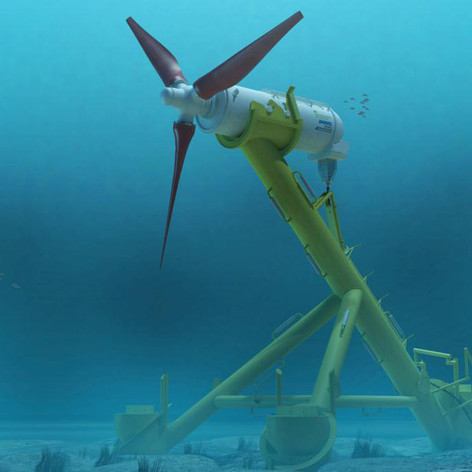Introduction
In a world increasingly driven by the need for sustainable energy solutions, tidal energy is emerging as a highly promising contender. Tidal stream energy stands out among various renewable sources due to its predictability and reliability. In the UK, tidal stream energy has the potential to meet up to 11% of the nation’s electricity demand, translating to about 11.5 GW of capacity. While the current installed capacity remains modest at 18 MW, the UK government is strongly backing the sector with initiatives such as the Contracts for Difference (CfD) scheme. This has already secured over 50 MW of new tidal stream capacity, and the latest announcements for AR6 identify plans for an additional 28 MW of tidal stream
capacity.

The SAE Renewables MeyGen project is leading the way for tidal steam project developers. Located in the turbulent waters of the Pentland Firth, Scotland, this project is the largest tidal steam project in the world and has generated more than 50 GWh of renewable energy. The MeyGen project not only marks a milestone in renewable energy innovation but also serves as a blueprint for the commercial viability of tidal stream energy.
Fraser Johnson, O&M Manager has been at the forefront of the MeyGen project since its inception. With over 20 years experience in marine renewables, Fraser, an industry veteran is well aware of the importance of involving the right-support and the right-time.
"Blackfish Engineering has been instrumental in the success of the MeyGen tidal stream project. Their critical engineering expertise and project management support were pivotal for key operations during the first phases of our project. Thanks to their contributions, MeyGen has remained at the cutting edge of tidal energy innovation, consistently delivering clean, renewable power to the grid."
MeyGen’s Vision and Early Challenges
The story of MeyGen began with a bold vision to harness the immense power of the tides in one of the world's most dynamic marine environments. Led by SAE Renewables (formerly SIMEC Atlantis Energy), the MeyGen project focused on realising this vision by using the early phase of the project as a demonstration effort selecting to deploy tidal stream turbines from Atlantis Resource LTD and Andritz Hydro. This technology-agnostic, project development approach sets MeyGen apart. Currently, many tidal stream developers are wearing two hats, that of the project developer and the technology developer - in essence bringing to market their own proprietary tidal stream technologies in their projects. The MeyGen project marks an inflexion point wherein tidal stream project development can happen separately from tidal stream technology development.
MeyGen secured its Agreement for Lease (AfL) from the UK’s Crown Estate in 2010, marking the beginning of what would become the world’s largest tidal stream project. From the outset, MeyGen faced significant challenges, not the least of which was the deployment of a subsea tidal turbine in the harsh environmental conditions of the Pentland Firth. However, backed by strong support from the Scottish Government and a commitment to innovation, the project began to take shape.
Phased Development: Key Milestones and Achievements
The MeyGen project is structured in multiple phases, each building on the lessons learned from its predecessor. Phase 1, the first phase of the project, entered its 25-year operations phase in April 2018, though it had been exporting energy into the grid since November 2016. It consists of four 1.5 MW turbines, each installed on three-legged, gravity-based foundations. Together, these turbines generated over 62 GWh of renewable electricity as of April 2024, underlining the feasibility and reliability of tidal arrays.
Following the success of Phase 1, with continued support from the UK CfD program, the project advances to phases 2 and 3, with plans to add 28 MW and 22 MW of capacity, respectively. Furthermore, MeyGen has long-term plans to expand its building consents to allow for the installation of a further 342MW of tidal capacity, allowing the full 398MW capacity of the project site to be exploited.
Project Phase | Capacity (MW) | CfD Award Round | Date of Operation |
|---|---|---|---|
1 | 6 | N/A | 2018 |
2 | 28 | AR4 | 2027 |
3 | 22 | AR5 | 2028 |
Future Phases | 6 | AR6 | 2028/2029 |
Future Phases | 336 | TBC | TBC |
Commercial Viability: Financial Structure and Economic Impact
One of the most compelling aspects of the MeyGen project is its demonstration of the commercial viability of tidal stream energy. This success is underpinned by a robust financial structure, supported by a combination of government grants, equity investment, and Contracts for Difference (CfDs). The UK Government, Scottish Enterprise, and various private investors have played crucial roles in ensuring the project's financial stability.
The Contracts for Difference mechanism has been particularly important. MeyGen secured CfDs from AR4 and AR5 guaranteeing £178.54 and £198.00 per MWh for phases 2 and 3 respectively, stabilising the revenues for both project phases for 15 years. Furthermore, £172/MWh was recently secured for a further 9MW capacity in allocation round 6 (AR6). This level of financial support has been vital in de-risking the investment and providing a clear revenue stream, enabling SAE Renewables to proceed with confidence into subsequent phases.
Beyond direct financial returns, the MeyGen project has had a significant economic impact on both the local and national economies. The supply chain for the project spans the United Kingdom, Europe, and North America, with 43% of the capital expenditure occurring in Scotland. The operational phase of the project has been managed from Nigg Energy Park, located in the sheltered waters of the Cromarty Firth in the Scottish highlands, with up to 55% of the project’s operational expenditure sourced locally.
Technical Innovations and Environmental Stewardship
At the heart of the MeyGen project are the tidal stream turbines they selected for demonstration in Phase 1. These are the AR1500, developed by SAE Renewables in partnership with Lockheed Martin, and the AH1000 MK1, developed by Andritz Hydro Hammerfest.
Lockheed Martin completed a detailed design of the AR1500 system in 2014. This system features pitching blades and complete nacelle yaw rotation capability, allowing for efficient operation in areas with high energy potential. The Andritz Hydro Hammerfest HS1500 utilizes pitched blades and yaw to feed a variable-speed conventional generator through a gearbox. An automatic control software, which governs a sensor-driven monitoring system, adjusts the leading edge to capture the optimal output from the tidal environment. Both turbines, each with a rotor diameter of 18 metres, are capable of generating 1.5 MW of power at current speeds of 3 metres per second.
The turbines are mounted on three-legged gravity foundations designed to withstand the extreme conditions of the Pentland Firth. Each foundation weighs approximately 1,450 tonnes, ensuring stability in flow speeds of up to 10 knots. The electricity generated by the turbines is transmitted via subsea cables to an onshore power conversion unit, where it is converted to grid-compliant voltage before being exported.
Left: Lockheed Martin AR1500 Tidal Turbine
Right: Andritz Hydro Hammerfest HS1500
The Role of Blackfish Engineering
As a key partner in the MeyGen tidal stream project, Blackfish Engineering leveraged our team's decades of tidal stream technology expertise. As the Innovators Engineer, our involvement spanned several critical areas, ensuring that our client not only met but exceeded the project objectives. The specific contributions we made include:
Mechanical Design and Systems Engineering: Wearing the hat of the Owners Engineer, we played a pivotal role in the detailed analysis and engineering of the Hammerfest turbine’s mechanical systems. Using the as-built engineering schematics and provided operational documentation our team systematically broke down the turbine into its key components, including the drivetrain, gearbox, generator, and monitoring systems to conduct a thorough analysis of the turbine’s reliable performance under the challenging marine conditions of the Pentland Firth.
Operational Efficiency and Project Management: Following the analysis of turbine reliability and performance, we made significant contributions to the project’s operational efficiency by developing on-shore maintenance strategies optimized to reduce turbine downtime and avoid large transport and installation costs. This focus on O&M efficiency directly impacts the project’s energy output and ensures operational targets are maintained for the generation of power from the turbines.
Risk Mitigation and Investor Confidence: By addressing complex engineering challenges, such as water ingress in turbine systems, we played a pivotal role in controlling technical risks associated with the MeyGen project. Our proactive approach to problem-solving and deep expertise in ocean renewable energy not only ensures the ongoing reliability of the turbines but also enhances investor confidence in the project’s long-term success.
To learn more about how Blackfish can help you increase operational efficiency, mitigate risk and grow investor confidence, get in touch using the button below.
The Future of Tidal Energy
The future of the MeyGen project is as promising as its past achievements. With Phases 2 and 3 set to add a combined 50 MW of capacity by 2028, the project is on track to deliver the world’s first commercial-scale tidal array. Beyond these phases, there are plans to expand the project to its full 398 MW capacity, further cementing the project's status as a global leader in tidal stream project development.
MeyGen has demonstrated that successful projects can be built by selecting and integrating the best available technologies. This adaptability, supported by partners like Blackfish Engineering, paves the way for similar projects around the world. The lessons learned from MeyGen’s phased development, technological innovations, and environmental monitoring will undoubtedly influence future tidal energy projects, helping to accelerate the adoption of this renewable energy source on a global scale.
Moreover, as the world continues to seek solutions to the climate crisis, the role of tidal energy will likely become increasingly important. Tidal energy offers a level of predictability that other renewable sources, such as wind and solar, cannot match. This predictability, combined with the advancements demonstrated by MeyGen, positions tidal energy as a critical component of the future energy mix.
Conclusion
The MeyGen project exemplifies the commercial opportunity for tidal stream energy production, representing a potential inflexion point in the industry, with a shift from technology developers taking their technology to market to technology-agnostic project developers expanding the potential for tidal energy in the mix of the energy landscape. From its ambitious beginnings to its current status as the largest tidal energy project in the world, MeyGen has continually demonstrated that the industry is ready and capable of overcoming the scale-up challenges and driving forward ocean renewable energy innovation. As the project moves into its next phases, it will continue to set new benchmarks for what is possible in the renewable energy sector. MeyGen is not just a success story for Scotland or the UK but for the global renewable energy community. Its achievements highlight the potential of tidal energy to contribute significantly to the world’s energy needs, offering a sustainable and reliable source of power for generations to come.











Comments